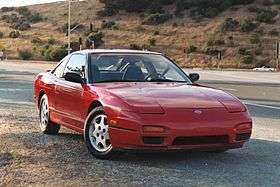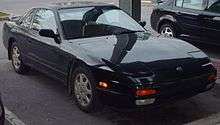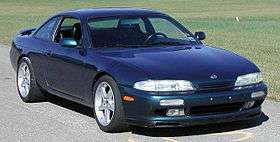Nissan 240SX
| Nissan 240SX | |
|---|---|
|
| |
| Overview | |
| Manufacturer | Nissan |
| Production | 1989–1999 |
| Assembly | Japan: Kanda, Fukuoka (Nissan Motor Kyūshū) |
| Body and chassis | |
| Class | Sports car |
| Layout | FR layout |
| Platform | Nissan S platform |
| Related | |
| Chronology | |
| Predecessor | Nissan 200SX |
The 240SX is a sports car that was introduced to the North American market by Nissan in 1988 for the following model year. It replaced the outgoing 200SX (S12) model. Most of the 240SX were equipped with the 2.4-liter inline 4 engine (KA24E from 1989–1990 and KA24DE from 1991–1999). The KA24E had a single overhead cam and KA24DE had dual overhead cams. Two distinct generations of the 240SX, the S13 (1989–1995) the S14 (1995-1999) were produced based on the Nissan S platform.
The 240SX is closely related to other S platform based vehicles, such as the Japanese-market Silvia and 180SX, and the European-market 200SX. Although their names are similar, the 240SX is unrelated to the 240Z or the 280ZX.
Although it is long out of production, it is still popular in drifting. However, due to the popularity of the S-chassis in drifting competitions, prices for vehicles and parts have sky-rocketed, this is sometime known as a "drift tax".
First Generation / S13 (1989–1994)
| First generation (S13) | |
|---|---|
 | |
| Overview | |
| Production | 1989–1994 |
| Body and chassis | |
| Body style |
2-door coupe 3-door hatchback 2-door convertible |
| Powertrain | |
| Engine | |
| Transmission |
|
| Dimensions | |
| Wheelbase | 2,474 mm (97.4 in) |
| Length | 4,521 mm (178.0 in) |
| Width | 1,689 mm (66.5 in) |
| Height | 1,290 mm (50.8 in) |
| Curb weight | 1,224 kg (2,698 lb) |
The first generation of the 240SX can be divided into two distinct versions, both having the sporting advantage of rear wheel drive standard. Each of these variants came in two distinct body styles: hatchback, which was offered in both base and SE trim, and coupe, which was offered in base, XE, LE and SE. Both styles shared the same front bodywork as the Japanese-market Nissan 180SX, featuring the sloping front with pop-up headlights. This bodywork distinguishes the coupe model from its Japanese-market counterpart, the Silvia, which featured fixed headlights. Both styles in all markets share the same chassis, and with few exceptions, most components and features are identical. The 240SX is a popular car in the sport of drifting due to its short wheelbase, low cost, ample power, and abundant aftermarket support. The 240SX is known as a vehicle that is purchased as a chassis for the ability to do a wide range of drivetrain swaps including SR20DET, 1JZ, 2JZ, LS1 and more.
1989 and 1990 models are powered by a naturally aspirated 140 horsepower (100 kW), 160 pound-feet (220 N·m) 2.4l SOHC KA24E engine with 3 valves per cylinder (instead of the turbo-charged and intercooled 1.8-liter DOHC CA18DET offered in Japan and Europe in the 180SX and Silvia). Four-wheel disc brakes were standard, with antilock brakes available as an option on the SE. Both models were offered with either a 4-speed automatic or 5-speed manual transmission. "Coupes" offered a Heads-up display (HUD) with a digital speedometer as part of the optional Power Convenience Group.

The 240SX received some updates in 1991. The matte silver, teardrop wheels were replaced by polished aluminium 7-spoke wheels that had better brake cooling properties but more drag. The nose was smoothed out by getting rid of the non-functional slots and gave back the aerodynamic efficiencies lost by the wheels. This gave the car an overhaul that included a minor update of the exterior and a new cylinder head. A new "LE" hatchback trim package was added that included leather interior. The SOHC KA24E was replaced by the DOHC KA24DE, now with 4 valves per cylinder, rated at 155 horsepower (116 kW) and 160 pound-feet (220 N·m). An optional sports package including ABS, a limited slip differential, and Nissan's HICAS four wheel steering was now available on hatchback models. In 1992, a convertible was added to the lineup and was exclusive to the North American market. These vehicles began life in Japan as coupes and were later modified in the California facilities of American Specialty Cars (ASC).[1] For the 1994 model year, the only available 240SX was a Special Edition convertible equipped with an automatic transmission. The US 240SX convertible differed from the Japanese market version, in that the Japanese market model had a power top cover boot, whereas the US market model had manually installed boot cover once the top is down.

The S13 was known for sharp steering and handling (thanks to front MacPherson struts and a rear multilink suspension) and relatively light weight (2700 lb) but was regarded in the automotive press as being underpowered. The engine, while durable, was a heavy iron-block unit that produced meager power for its relatively large size. It was only modestly improved by the change to the DOHC version in 1991. These engines are the primary difference between the North American 240SX and the world-market Silvia/180SX/200SX. The KA24DE did not come turbocharged while the SR20DET did. The U.S. version was regarded as a highly capable sports car that only needed a better engine. Other differences include a standard limited slip differential on overseas and Canadian models, available digital climate control in Japan, and manual seat belts standard in Japan and Canada vs. automatic restraint seatbelts in America.
The 240sx S13 model came standard with a dual tip exhaust system, as well as a single tip exhaust system.
Second generation / S14 (1994–1998)
| Second generation (S14) | |
|---|---|
 | |
| Overview | |
| Production | 1994–1998 |
| Body and chassis | |
| Body style | 2-door coupe |
| Powertrain | |
| Engine | 2.4 L KA24DE I4 (gasoline) |
| Transmission |
|
| Dimensions | |
| Wheelbase | 2,525 mm (99.4 in) |
| Length | 4,498 mm (177.1 in) |
| Width | 1,727 mm (68.0 in) |
| Height | 1,288 mm (50.7 in) |
| Curb weight | 1,253 kg (2,762.4 lb) |
The 240SX was released in the spring of 1994 as a 1995 model. The hatchback and convertible body styles were eliminated, leaving only the coupe. The wheelbase car grew 2 in (51 mm) and the track width was also increased, while the overall length of the vehicle was slightly shorter than the previous generation. The curb weight of the vehicle increased by about 80 lb (36 kg) relative to the 1994 model.[2] Dual air bags were added and the automatic seatbelts were replaced with common manual type. The pop-up headlights were removed in favor of fixed lamps. Though the general layout remained the same, almost all parts were redesigned to the extent that very few parts are interchangeable. The chassis was changed slightly to increase stiffness (Nissan claimed 50% torsional, 100% bending rigidity increase) and utilized higher rear strut mounts. The fuel tank, previously located at the rear end under the trunk floor, now sat in front of the rear suspension and behind the rear seats.
The base model had 4-lug, 15-inch wheels, a softer suspension, and no rear sway bar. The base model had several options and features available to be fitted to the car such as leather seats, ABS, & a viscous limited-slip differential. SE and LE models came equipped with 5-lug, 16-inch alloy wheels, a stiffer suspension than the base model, and a rear sway bar. The LE was basically an upgraded SE model, but with more standard equipment such as leather seats, keyless entry, an antitheft system, and a CD player. Antilock brakes and a viscous limited-slip differential could be had as an optional package to both base and SE/LE models.

In 1997, the 240SX received minor updates. The different looks of the S-Chassis are referred to as before change "Zenki" and after change "Kouki". Changes were mostly aesthetic, including new projector headlights, front bumper, hood, fenders, and revised taillights and center panel. Side skirts became standard on the SE and LE trim level. 1998 marked the end of production for the Nissan 240SX, with no further variations released in North America. The later generation of the 240SX suffered in sales due to the competition from other car manufacturers and consumers at the time choosing more practical vehicles, such as a SUV. Every 240SX was built in Kyūshū, Japan. The last 240SX rolled off the assembly line on July 23, 1998.
References
- ↑ "ASC, American Sunroof Corporation, ASC Custom Craft, Heinz C. Prechter, ASC Holdings, American Specialty Cars, ASC/McLaren - Coachbult.com". Coachbuilt.com. Retrieved 2010-10-15.
- ↑ "1995 Nissan 240SX Road Test: Performance, Engine, Transmission, Suspension, Brakes, and Handling". Automotive.com. Retrieved 2010-10-15.
| « previous — Nissan road car timeline, United States and Canadian markets, 1980s–present | ||||||||||||||||||||||||||||||||||||||
|---|---|---|---|---|---|---|---|---|---|---|---|---|---|---|---|---|---|---|---|---|---|---|---|---|---|---|---|---|---|---|---|---|---|---|---|---|---|---|
| Type | 1980s | 1990s | 2000s | 2010s | ||||||||||||||||||||||||||||||||||
| 0 | 1 | 2 | 3 | 4 | 5 | 6 | 7 | 8 | 9 | 0 | 1 | 2 | 3 | 4 | 5 | 6 | 7 | 8 | 9 | 0 | 1 | 2 | 3 | 4 | 5 | 6 | 7 | 8 | 9 | 0 | 1 | 2 | 3 | 4 | 5 | 6 | ||
| Subcompact | Micra | Micra | ||||||||||||||||||||||||||||||||||||
| Versa (hatchback) | Versa Note | |||||||||||||||||||||||||||||||||||||
| 210 | Sentra | Sentra | Sentra | Sentra | Versa (sedan) | Versa (sedan) | ||||||||||||||||||||||||||||||||
| Compact | 310 | Sentra | ||||||||||||||||||||||||||||||||||||
| 510 | Stanza | Stanza | Stanza | Altima | Altima | |||||||||||||||||||||||||||||||||
| 810 | Maxima | Maxima | ||||||||||||||||||||||||||||||||||||
| Mid-size | Sentra | Sentra | ||||||||||||||||||||||||||||||||||||
| Leaf | ||||||||||||||||||||||||||||||||||||||
| Altima | Altima | Altima | ||||||||||||||||||||||||||||||||||||
| Maxima | Maxima | Maxima | ||||||||||||||||||||||||||||||||||||
| Full-size | Maxima | Maxima | Maxima | |||||||||||||||||||||||||||||||||||
| Sport compact | Pulsar NX | Pulsar NX | NX | 200SX | Altima Coupe | |||||||||||||||||||||||||||||||||
| 200SX | 200SX | 240SX | 240SX | |||||||||||||||||||||||||||||||||||
| Sports | 280ZX | 300ZX | 300ZX | 350Z | 370Z | |||||||||||||||||||||||||||||||||
| GT-R (R35) | ||||||||||||||||||||||||||||||||||||||
| Note | Vehicle sold only in Canada. | |||||||||||||||||||||||||||||||||||||